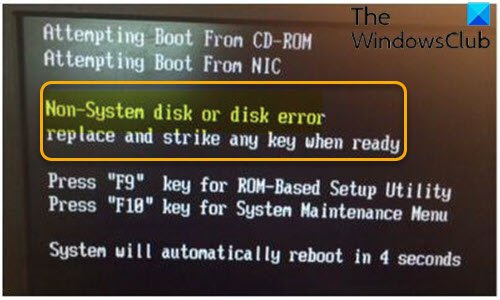You may encounter this error if the computer BIOS cannot find a bootable operating system on any of the storage devices included in its boot path, or it fails to locate the boot disk. Similar error messages include Boot device not found, Operating system not found, or Missing operating system.
Non-system disk or disk error Black screen
If you’re faced with this issue, you can try our recommended solutions below in no particular order and see if that helps to resolve the issue. Let’s take a look at the description of the process involved concerning each of the listed solutions.
1] Remove all Non-System Disks
In troubleshooting the Non-system disk or disk error black screen, we start off by removing the non-system disk from your boot device (remove any non-system disk from the floppy drive or eject the disk from the CD-ROM drive), then turn off and on the computer and see if that worked. If not, try the next solution.
2] Confirm Boot Priority
This solution requires you to make sure that you select a device that has boot files (or operating system files) installed, and set it to the first place of the boot order.
3] Remove and reinstall the Hard Drive
If you started experiencing this issue after the computer was dropped or received a hard knock, it’s possible there’s a disconnection between the computer and hard drive, most likely the cables are loose or the drive shifted from its position. In this case, you need to check the HDD’s IDE or SATA cable and make sure that the cable connecting the HDD to the motherboard is fastened securely, and then restart your PC. You can also remove and reinsert the drive. To remove and reinstall the drive, do the following: You may need the services of a hardware technician.
Turn off the computer and disconnect from the power source.Remove the battery from the bay (if it is a laptop).Remove the system disk.Reinstall the system disk.Reinsert the battery into the bay (if it is a laptop).Power on the computer.
If the computer boots successfully, all fine and good, otherwise try the next solution.
4] Perform Startup Repair
This solution requires you to perform Windows Startup Repair and see if that helps.
5] Repair MBR
If the area where the Master Boot Record is located contains a few defective clusters, the MBR is rendered unreadable, which could lead to this error when you boot your computer. You could repair the Master Boot Record and see.
6] Set System Partition Active
If for some reason the system partition is set inactive, you may encounter this error. In this case, you’ll need to manually set the system partition as active. Here’s how: You’ll need Windows 11/10 bootable media to carry out this task. On any working PC, create a Windows installation USB drive, if you don’t have one readily available. You can create the Windows 11/10 installation media on a Linux or Mac computer if those are what you have access to. Then, proceed as follows:
Boot the faulty PC using the Windows 10 installation media.The Windows Setup dialog box will appear.Set the Time and currency format, Keyboard or input method, and the language to install.Click Next.Click on Repair your computer from the lower-left corner.From the Choose an option screen, click on Troubleshoot.Click Advanced Options in the Troubleshoot screen.In the Advanced Options screen, click Command Prompt.In the CMD window, type the following commands and hit Enter after each line:
The System drive is always configured as disk 0. However, enter the correct number in your own case. The System partition is always configured as partition 1. However, enter the correct number in your own case. Restart the computer and see if the issue persists. If so, try the next solution.
7] Run CHKDSK
This solution requires you to run CHKDSK to repair bad sectors (if any) and see if the computer will boot normally.
8] Replace Hard Drive
As a last resort, when you have exhausted all available options and the issue is still unresolved, it’s most likely the drive has packed in. In which case, you need to replace your hard drive and clean install Windows 10. But before you do, you need to run a S.M.A.R.T check to determine if the hard drive has failed or disk failure is imminent. Hope this helps!

